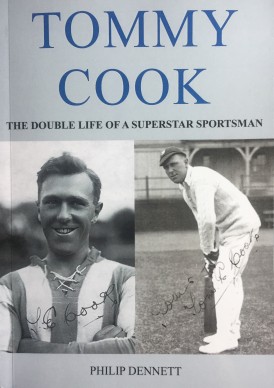Tommy Cook
Martin Chandler |Published: 2021
Pages: 262
Author: Dennett, Philip
Publisher: Whistlebower
Rating: 3.5 stars

Tommy Cook was a free scoring centre forward for Brighton and Hove Albion through the 1920s and, despite playing for a club in the Third Division (South), won a single full international cap for England against Wales in 1925. One of a number of men who, in that era, was able to successfully combine careers in soccer and cricket, Cook was also a fine batsman and occasionally useful medium paced bowler who, over a decade and a half, scored more than 20,000 runs for Sussex.
Retired journalist and man of Sussex Phil Dennett has written and published this biography of Cook. I am pleased to report that, as you would expect from a man with his background, Dennett is a decent writer and, having chosen a man who led an interesting life which came to a sad end less than a fortnight after his forty ninth birthday, he has produced a first book that, even if he is more of a soccer man than a cricket one, is well worth any cricketing bibliophile’s time, particularly if he or she is a Sussex supporter.
Tommy Cook is very much a full biography, beginning with Cook’s origins and his childhood, and two particular contrasting episodes from that. The first was an appearance before the magistrates for the heinous offence of riding a pedal cycle after dark without lights, and the second his, as was not uncommon, lying about his age in order to join the Royal Navy and help his country by seeing service in the Great War.
With the return of peace in the 1920s Cook’s dual sporting career began and has clearly been thoroughly researched. The narrative in other hands might at this point have become monotonous, but Dennett does much more than just trot out statistics and match descriptions, and indeed looks beyond Cook’s personal achievements to examine the place sport occupied in the hearts and minds of the people of Sussex.
Outside sport Cook’s life was not so straightforward. He married three times and the end of his second marriage, in 1937, coincided with the end of his Sussex career at a time when he was still in form and, in 1930s terms, relatively young. His decision was to take the not insubstantial proceeds of his benefit year to South Africa, where he had coached in the past, and start a new life.
In South Africa Cook met his third wife, and in time he joined the South African Air Force. He suffered serious physical injuries when he was thrown clear in an air accident where everyone else on board died. Those physical injuries took months to heal, but it seems the psychological ones never did. By 1947 the third marriage was over and, in what seem remarkable circumstances, Cook was persuaded to return to Sussex.
At this point Cook had been away from England for a decade, and had no experience of football management, yet a desperate Brighton and Hove Albion persuaded him to take over the managerial reins at his old club. The move was not a success and Cook did not last the season. His physical health fragile and his mental health poor Cook’s life then went downhill and early in 1950 he took an overdose of sleeping tablets. By then living with his mother he was rushed to hospital, but it was too late to save him.
Dennett attempts, in a sympathetic way, to unravel Cook’s demons. It is a task which, as far as it is possible to do, he completes very well and the book is a fitting tribute to a forgotten great of Sussex and England sport, and a topical reminder of how fragile mental health has always been, and the particular risks in relation to that that professional sportsmen have to bear.
As far as the production standards of Tommy Cook are concerned those are, for what is essentially a private publication, pretty good. There are a number of appendices containing, in the main, statistics. The unconventional way that the cricket stats are presented suggest that Dennett has not studied too many cricketers’ biographies, but they are interesting nonetheless. Where some of these books fall down is in the selection of and reproduction of the images that they contain, but that certainly isn’t the case here, and there is a usable index. In fact my only real complaint is that no one bothered to click on the ‘justify’ button in the typesetting phase, something of a personal hobbyhorse, ever since I was traumatised by a secretary a couple of decades ago as she admonished me rather harshly after I had proudly shown her the first letter I had ever produced myself – the memory has haunted me ever since.






Leave a comment